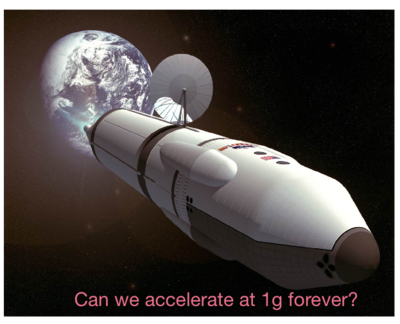Artificial Gravity

You decide to set off on a voyage to another star. To stop your muscles from atrophying, you want to generate artificial gravity by having your ship constantly accelerate at 1 g from your reference frame.
Ignoring fuel requirements, is there a problem with generating artificial gravity this way over very long time frames?
This section requires Javascript.
You are seeing this because something didn't load right. We suggest you, (a) try
refreshing the page, (b) enabling javascript if it is disabled on your browser and,
finally, (c)
loading the
non-javascript version of this page
. We're sorry about the hassle.
Relativity is based on the idea that you can't tell how fast you're moving without being given a reference frame. This means that you can accelerate at any rate without worrying about the speed of light barrier. Of course you would never reach the speed of light from any reference frame as due to time dilation your time would move slower the closer to c you got. This means that any external observer would say you're acceleration was decreasing.